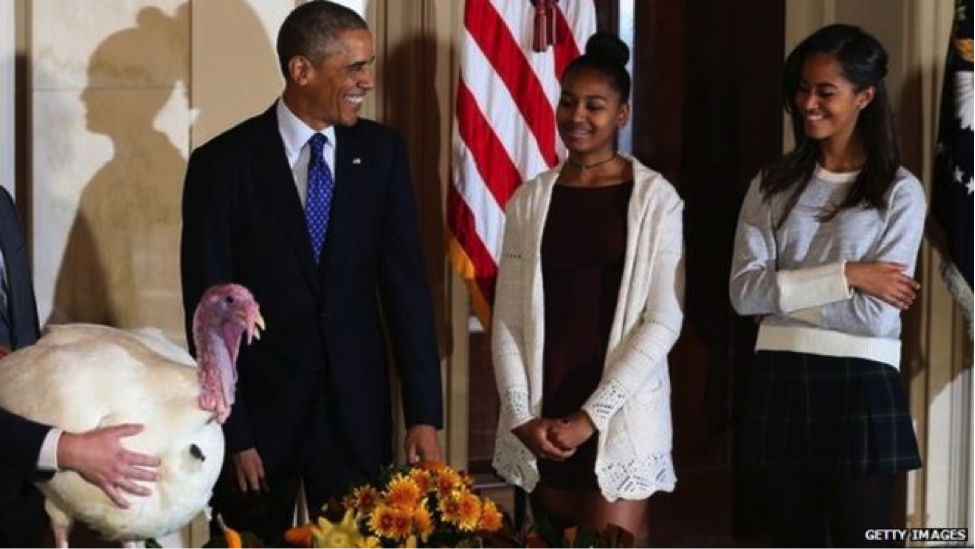By: Francis Cullo
On November 23, the day before Thanksgiving, President Obama will pardon a turkey (or two) for the eighth and final time in his presidency. This
lighthearted tradition dates back to the
Truman White House, although some trace the practice back to
Lincoln’s clemency of a turkey all the way back in 1863.
It is a somewhat
absurd tradition. For one thing turkeys have not even committed a crime! But so many of our
Thanksgiving traditions are absurd. The
National Turkey Federation (yes, it’s a real lobbying organization) sponsors the
White House ceremony. The Federation pays for the pardoned turkeys to arrive to the White House by
motorcade flanked by Secret Service agents.
For all the pomp and circumstance of the Thanksgiving ceremony, President Obama is a reluctant pardoner in another way as well. Obama trails every two-term president in
number of pardons except for our first president George Washington, favoring instead the use of commutations.
Executive clemency powers are serious business, and should not be taken lightly. However, under
federal mandatory minimum standards, non-violent first-time offenders are not
eligible for parole, and many are serving harsh sentences. That makes executive clemency powers effectively the only safety valve for alleviating these sentences. While any executive clemency action should be thoughtfully considered, a full pardon does more to help a certain class of prisoners get back on to their feet after incarceration than a commutation.
Commutations
do important work in addressing abuses and a history of over-criminalization in the United States, it does not go far enough in helping these Americans to adjust and succeed in life after prison. The pardon power, when used judiciously, is better able to tackle these problems by restoring important rights of citizenship and making employment possible.
Why so few pardons?
Both a pardon and commutation are a part of the Executive branch’s
Article II clemency powers. A Governor has clemency powers over
state prisoners, as opposed to federal prisoners which are the purview of the president.
A
pardon allows the executive to “forgive” a person for their crime. It effectively cuts off any remaining prosecution and removes both the sentence and any remaining penalties.
In contrast, a
commutation, does not go as far. A commutation is a “reprieve.” It cuts short the sentence a person serves, but does not get rid of the sentence or label of a criminal sentence.
Although the executive has the final say in who does or does not get a pardon or commutation, there are checks and balances built into the system. The Department of Justice employs
pardon attorneys who oversee and assist the President in exercising these powers. They review petitioners for pardons and vet those petitioners to see which cases merit clemency. This control mechanism provides review and oversight to ensure that only worthy cases are recommended for pardons. That allows both the public and the president some modicum of comfort.
One explanation for the lack of pardons by the Obama administration is the President’s unprecedented
number of commutations in the post-Cold War era. Many of these commutations are for
non-violent drug offenders. A commutation, then, is somewhat of a compromise. It does some of the work of a pardon, namely releasing a prisoner from incarceration, without fully forgiving the person. It is more politically expedient for Obama to commute a sentence than to offer a full presidential pardon.
The conditions that come along with a commuted sentence are sometimes difficult to complete, which caused one federal inmate recently to
refuse a commuted sentence.
This
Time piece highlights how difficult life can be for a person after a commuted sentence. Barbara Scrivner spent 21 years behind bars before her sentence was commuted in late 2014. Her recently deceased father’s house was reverse mortgaged, driving her into a halfway house. A condition of staying there was getting a job, which is not easy for someone who last found employment in the 1980s.
Presidential pardons are a matter of public intrigue and
grand speculation. Lame duck presidents like President Obama have a tendency to offer
more clemency. Pardons are always a political matter. Recent calls to pardon high-profile people like
Edward Snowden,
Chelsea Manning, and
Leonard Peltier demonstrate how the debate about whom to pardon takes place in the public eye. Famously, President
Bill Clinton pardoned 176 people in his last
2 hours in office. However, most people have never heard of the vast majority of people pardoned.
While
high-profile pardon cases steal the headlines, commutations are less politically risky. As Obama continues to prefer
commutations over pardons, it is important to reflect upon what this might mean for clemency powers in the social media age.
In the past, the public relied on newspapers and journalists to do the digging and see who was pardoned and why. Now it is a simple matter of logging on to see the list of pardons on the
Department of Justice’s website. Ordinary citizens can more easily participate in this process by signing petitions on the White House’s website, like
this one for Edward Snowden. It amassed over
100,000 signatures, which triggers a response from the White House.
The ease of obtaining information and access means that it is also easy to drum up fervor over
politically unpopular pardons. It is understandable that Obama is reluctant to use the pardon power when commutation remains an option and does not create the same political firestorm.
But the executive pardon power serves an important function, if used judiciously. It is an important tool for providing a second chance to a certain sector of Americans most wounded by harsh punishments. A commutation reduces a prison sentence, but it does not restore important civil rights like the
ability to vote.
In his final days in office Obama should at the very least reconsider his approach to offering commutations, and perhaps not be afraid to use the full weight of a presidential pardon for US citizens who could benefit from them most.


